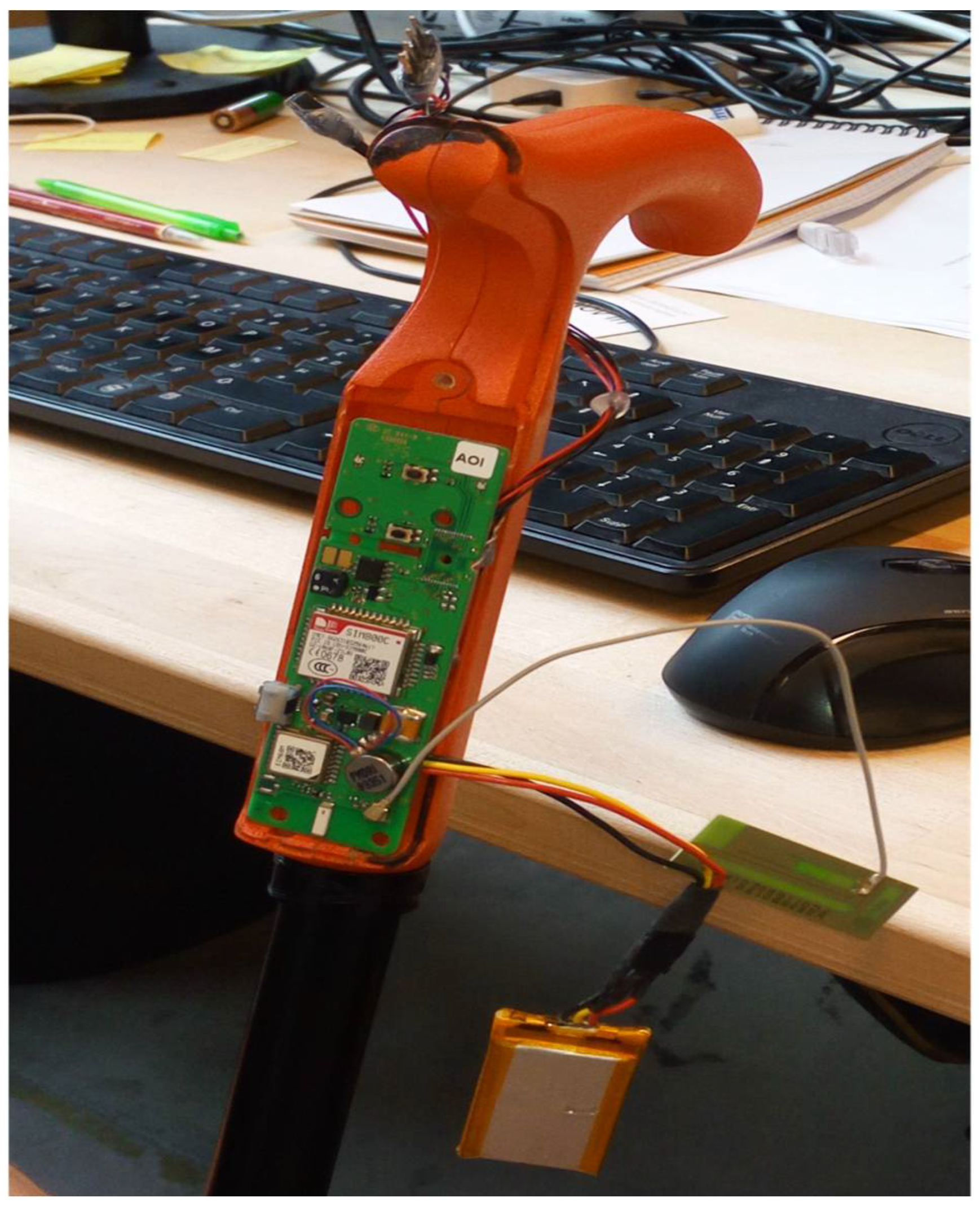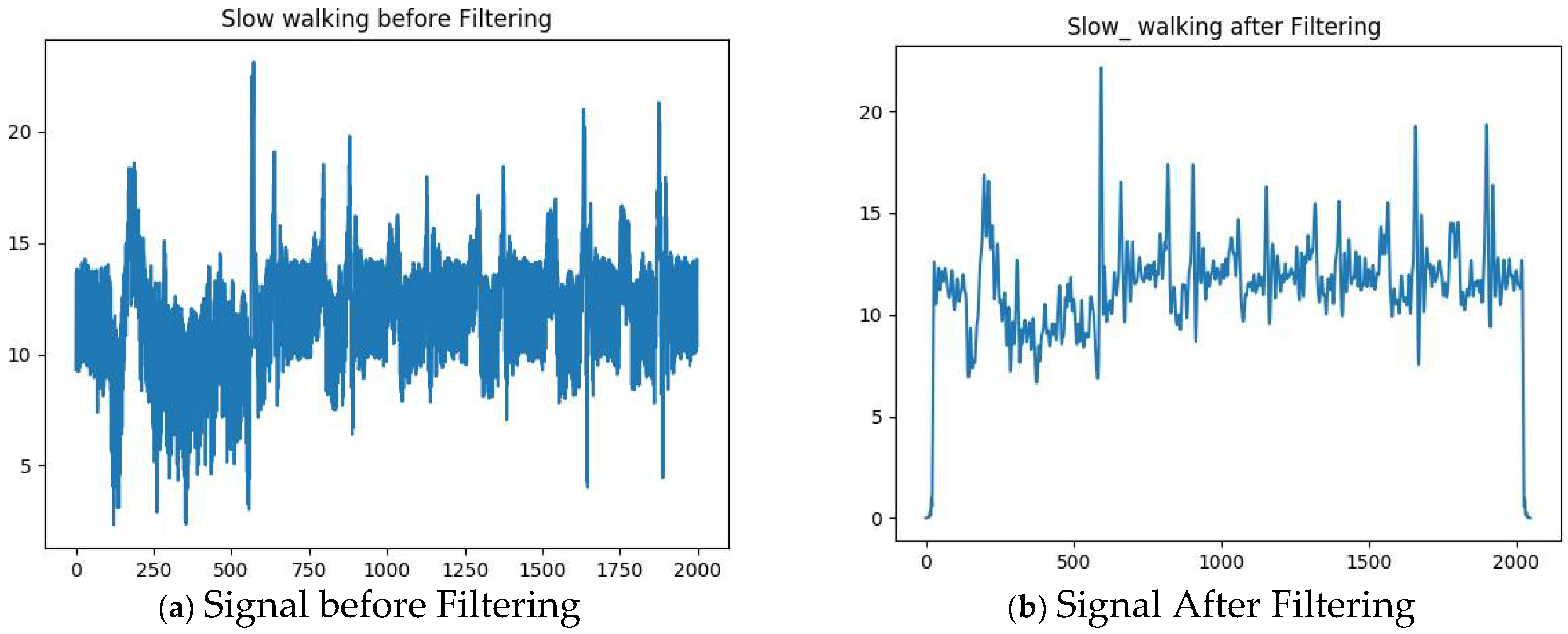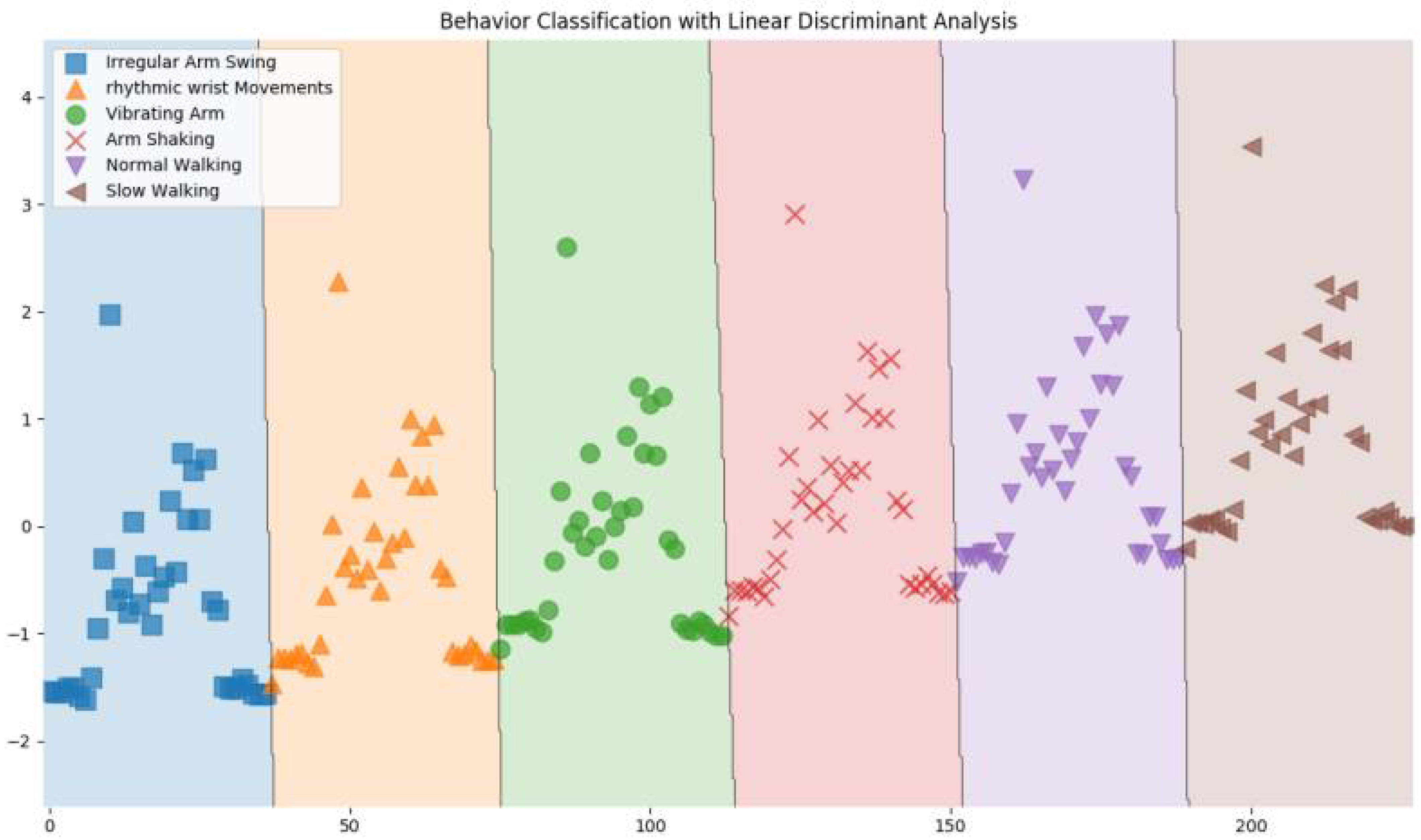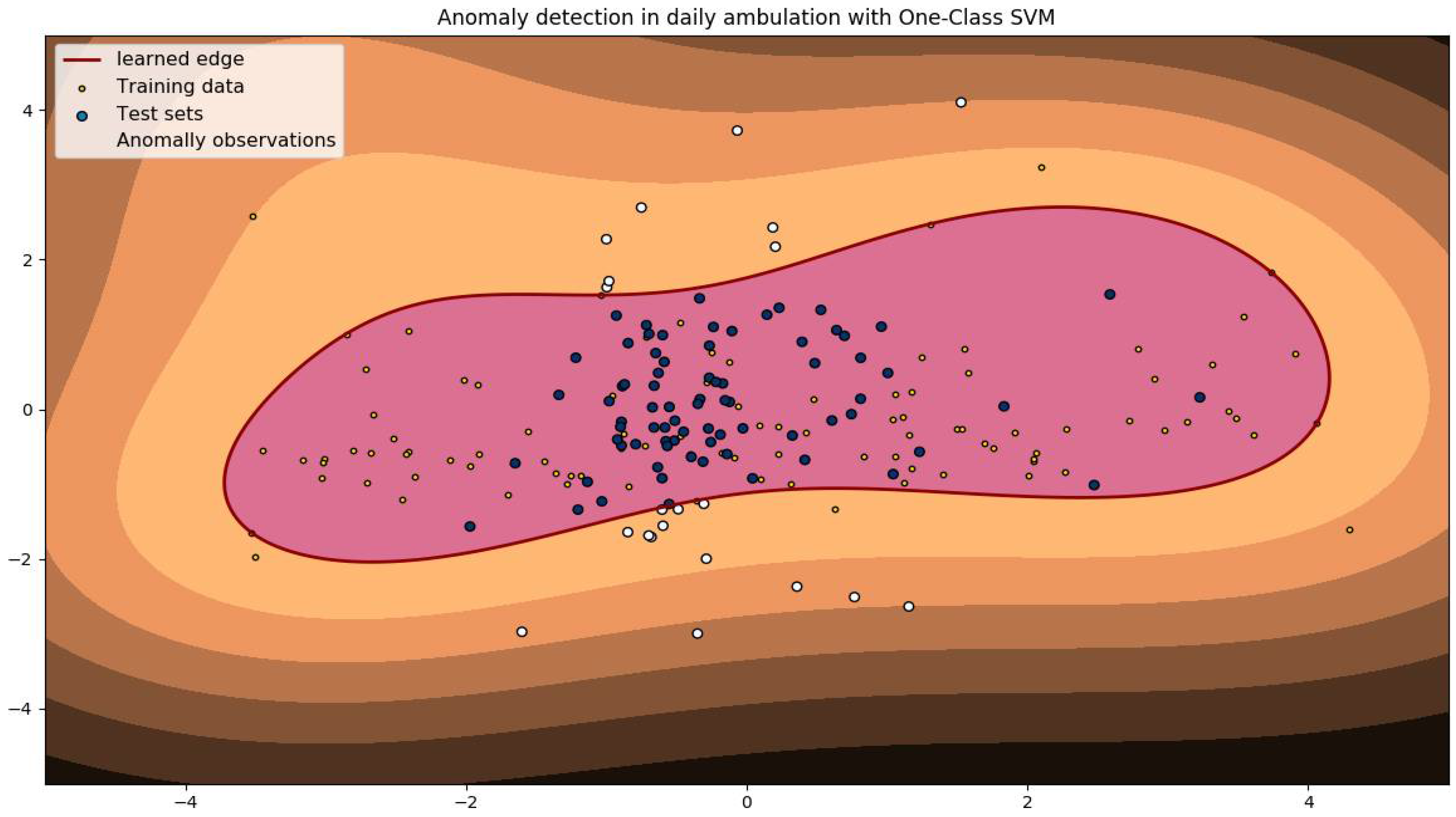Abnormal Gait and Tremor Detection in the Elderly Ambulatory Behavior Using an IoT Smart Cane Device
Abstract
1. Introduction
1.1. Gait Abnormality and Ambulation Pattern
1.2. Elderly Activities Evaluation
1.3. Overview of This Paper
2. Related Work
Drawback of the Existing Methods
3. Material and Methods
3.1. Tremor Detection
3.2. Perception Layer
3.3. Storage Layer
3.4. Smart Learning Platform
4. Activities Simulation
4.1. Filtering and Noise Removal
4.2. Feature Extraction
4.3. Energy Feature
4.4. Dimension Reduction with PCA
4.5. Classification Using LDA
5. Anomaly Detection in Gait Ambulation
- Activity begin time;
- Activity end time;
- Number of steps.
- Pause begin time;
- Pause end time.
- Fall time;
- Fall alert (false when cancel otherwise true).
Data Description
- Date: This represents the day column and the day the activity was carried out;
- Step count: The total number of steps taken by the user on a particular day;
- Pause duration: The total duration of a pause by the user during activity, represented in seconds;
- Mood: This is a heuristic feature that intends to express the user’s feeling on a particular day. Although this is assumed not to be 100 percent accurate, it might be interesting to estimate the user’s daily mood. It turns out that an average person has a step of approximately 2.1 to 2.5 feet. Therefore, it takes approximately 2200 steps to walk one mile, and a step count of 1000 will cover about 762 m, so if an aged person (who is mentally stable) can take about 3000 steps on a particular day, which is more than a one-mile walk, then he/she is assumed to be in a great shape and excellent mood. It is computed based on the following algorithm;
- walk_duration = []
- for i in range (0, len(walk_duration)):
- if walk_duration >= 3000:
- mood is ’Excellent Mood’
- elif walk_duration >= 1000:
- mood is ’Very good mood’ else:
- mood is ’moody’Mood is represented in binary as follows:100 = moody, 200 = Very good mood, and 300 = Excellent Mood.
- Activity length: This is the beginning of a daily activity literately when the cane is picked up.
- Activity end: This is the end of a daily activity literately when the cane is finally laid to rest and no activation is detected for the rest of the day.
- Activity length: This is the length of total activity for the day. It is computed from the sum of the difference in the activity end time and activity begin time. It is then converted into second(s).
- True falls: A true fall is detected when the cane loses its equilibrium, and balance is not regained within a 15 s interval.
- Walk duration: This can be referred to as total active moments of the day because it represents the total duration of ambulation by the user. It is computed by taking the sum of activity length and subtracting the total pause duration.
- Tiredness: This is the rate of exhaustion that maybe experienced by the user. Tiredness may be due to fatigue, or it may be a sign of physical weakness experienced as one grows older. It can also be an indicator of distress. It is computed by taking the ratio of pause duration to the walk duration. It may be noted that threshold can be set for this, and a distress alert can be generated if tiredness is greater than 1. This is not a good sign because it means the user pauses more often than doing the actual walking, although it may not be 100 percent accurate because the user may pause to talk to people or due to some other reasons.
- Speed: This is the rate of change in distance of the user. We can estimate how fast the user moves, and this is computed by taking the ratio of step count to walk duration.
- False falls: This is a trigger alert when the cane loses its equilibrium, but it is cancelled when the cane is picked up within a 15 s time frame.
- True fall time: This is the time when true falls occur.
- False fall time: This is the time when false falls occur.
6. Anomalies Detection with Isolation Forest and One-Class SVM
6.1. Detecting Anomaly with Isolation Forest (Liu and Ting, 2012)
6.2. Detecting Anomaly with One-Class SVM
7. Discussion
8. Conclusions
8.1. Limitations of the Proposed Approach
8.2. Prospects for Future Research
Author Contributions
Funding
Institutional Review Board Statement
Informed Consent Statement
Data Availability Statement
Acknowledgments
Conflicts of Interest
References
- World Population Ageing; Technical Report; UN World Health Organization: Geneva, Switzerland, 2013; Volume 374, pp. 1–95.
- Medical News Today. Available online: https://www.medicalnewstoday.com/articles/320481.php (accessed on 10 October 2017).
- Nutt, J.G.; Marsden, C.D.; Thompson, P.D. Human walking and higher-level Gait disorders, particularly in the elderly. Neurology 1993, 43, 268–279. [Google Scholar] [CrossRef]
- Zolfaghari, S.; Keyvanpour, M.R. Smart Activity Recognition Framework in Ambient Assisted Living. In Proceedings of the 2016 Federated Conference on Computer Science and Information Systems, Gdansk, Poland, 11–14 September 2016. [Google Scholar] [CrossRef]
- Luo, J.; Tang, J.; Xiao, X. Abnormal Gait Behavior Detection for Elderly Based on Enhanced Wigner-Ville Analysis and Cloud Incremental SVM Learning. J. Sens. 2016, 2016, 5869238. [Google Scholar] [CrossRef]
- Sagawa, K.; Ishihara, T.; Ina, A.; Inooka, H. Classification of human moving patterns using air pressure and acceleration. Industrial Electronics Society, 1998. In Proceedings of the IECON ’98, 24th Annual Conference of the IEEE, Aachen, Germany, 31 August–4 September 1998; Volume 2, pp. 1214–1219. [Google Scholar]
- Yang, J.-Y.; Wang, J.-S.; Chen, Y.-P. Using acceleration measurements for activity recognition: An effective learning algorithm for constructing neural classifiers. Pattern Recognit. Lett. 2008, 29, 2213–2220. [Google Scholar] [CrossRef]
- Cheng, J.; Amft, O.; Lukowicz, P. Active Capacitive Sensing: Exploring a New Wearable Sensing Modality for Activity Recognition. In Proceedings of the International Conference on Pervasive Computing, Helsinki, Finland, 17–20 May 2010. [Google Scholar]
- Medrano, C.; Igual, R.; Plaza, I.; Castro, M. Detecting Falls as Novelties in Acceleration Patterns Acquired with Smartphones. PLoS ONE 2014, 9, e94811. [Google Scholar] [CrossRef]
- Mubashir, M.; Shao, L.; Seed, L. A survey on fall detection: Principles and approaches. Neurocomputing 2013, 100, 144–152. [Google Scholar] [CrossRef]
- Noury, N.; Herd, T.; Rialle, V.; Virone, G.; Mercier, E.; Morey, G.; Moro, A.; Porcheron, T. Monitoring Behaviour in Home Using a Smart Fall Sensor and Position Sensors. In Proceedings of the 1st Annual International Conference On Micro Technologies in Medicine and Biology, Lyon, France, 12–14 October 2000; pp. 607–610. [Google Scholar]
- Moschetti, A.; Fiorini, L.; Esposito, D. Toward an Unsupervised Approach for Daily Gesture Recognition in Assisted Living Applications. IEEE Sens. J. 2017, 17, 8395–8403. [Google Scholar] [CrossRef]
- Naranjo-Hernández, D.; Roa, L.M.; Reina-Tosina, J.; Estudillo-Valderrama, M.A. SoM: A smart sensor for human activitymonitoring and assisted healthy ageing. IEEE Trans. Onbiomedical Eng. 2012, 59, 3177–3184. [Google Scholar] [CrossRef]
- Pogorelc, B.; Bosnić, Z.; Gams, M. Automatic recognition of gait-related health problems in the elderly using machine learning. Multimed. Tools Appl. 2012, 58, 333–354. [Google Scholar] [CrossRef]
- Palmerini, L.; Bagalà, F.; Zanetti, A.; Klenk, J.; Becker, C.; Cappello, A. A wavelet-based approach to fall detection. Sensors 2015, 15, 11575–11586. [Google Scholar] [CrossRef]
- Xiang, T.; Gong, S. Incremental and adaptive abnormal behaviour detection. Comput. Vis. Image Underst. 2008, 111, 59–73. [Google Scholar] [CrossRef]
- Zhang, D.; Peng, H.; Haibin, Y.; Lu, Y. Crowd abnormal behavior detection based on machine learning. Inf. Technol. J. 2013, 12, 1199–1205. [Google Scholar] [CrossRef][Green Version]
- Bauckhage, C.; Tsotsos, J.K.; Bunn, F.E. Automatic detection of abnormal gait. Image Vis. Comput. 2009, 27, 108–115. [Google Scholar] [CrossRef]
- Khan, Z.A.; Sohn, W. Abnormal human activity recognition system based on R-transform and kernel discriminant tech-nique for elderly home care. IEEE Trans. Consum. Electron. 2011, 57, 1843–1850. [Google Scholar] [CrossRef]
- Ma, X.; Wang, H.; Xue, B.; Zhou, M.; Ji, B.; Li, Y. Depthbased human fall detection via shape features and improved extreme learning machine. IEEE J. Biomed. Health Inform. 2014, 18, 1915–1922. [Google Scholar] [CrossRef]
- What Is Tremor? Available online: https://www.medicinenet.com/tremor/article.htm (accessed on 21 November 2017).








| Category | Description | Recognition Accuracy (%) | Algorithm |
|---|---|---|---|
| Irregular Arm Swing | Arm movements lacking continuity of occurrence | 89.9 | LDA |
| Resting | In a relax state | 97.6 | LDA |
| Vibrating Arm | Arm shaking vigorously | 97.8 | LDA |
| Exhausted | Tired | 98.1 | LDA |
| Normal Walking | Expected state of Walking | 99.7 | LDA |
| Slow Walking |
Less than expected state of walking (An average person has a step of approximately 2.1 to 2.5 feet. Therefore, it takes approximately 2200 steps to walk one mile, also it takes 15 to 20 min to accomplish for an average individual according to the Centers of Disease Control and Prevention) | 99.6 | LDA |
| Activity Data | Precision | Recall | F1-Score | |
|---|---|---|---|---|
| Vibrating Arm | 0 | 0.98 | 0.98 | 0.98 |
| 1 | 0.03 | 0.03 | 0.02 | |
| Accuracy | 0.97 | |||
| Micro Avg | 0.89 | 0.89 | 0.89 | 0.99 |
| Weighted Avg | 0.96 | 0.95 | 0.97 | 0.97 |
| Activity Data | Precision | Recall | F1-Score | |
|---|---|---|---|---|
| Vibrating Arm | 0 | 0.9 | 0.98 | 0.98 |
| 1 | 0.12 | 0.12 | 0.12 | |
| Accuracy | 0.98 | |||
| Micro Avg | 0.88 | 0.89 | 0.89 | 0.99 |
| Weighted Avg | 0.98 | 0.99 | 0.98 | 0.97 |
| Activity | Wagner Analysis [5] | Noury et al. [11] | Alessandra Moschetti et al. [12] | Smart Cane Method |
|---|---|---|---|---|
| Normal Walking | 100% | 91% | 90% | 99.7% |
| Slow Walking | Not Evaluated | Not Evaluated | Not Evaluated | 99.6% |
| Exhausted | Not Evaluated | Not Evaluated | Not Evaluated | 98.1% |
| Vibrating Arm | Not Evaluated | Not Evaluated | Not Evaluated | 97.8% |
| Resting | 91.6% | 91.2% | 87.8% | 97.6% |
| Irregular Arm Swing | Not Evaluated | Not Evaluated | Not Evaluated | 89.9% |
Publisher’s Note: MDPI stays neutral with regard to jurisdictional claims in published maps and institutional affiliations. |
© 2022 by the authors. Licensee MDPI, Basel, Switzerland. This article is an open access article distributed under the terms and conditions of the Creative Commons Attribution (CC BY) license (https://creativecommons.org/licenses/by/4.0/).
Share and Cite
Adebiyi, M.O.; Abdulrasaq, S.; Olugbara, O. Abnormal Gait and Tremor Detection in the Elderly Ambulatory Behavior Using an IoT Smart Cane Device. BioMedInformatics 2022, 2, 528-543. https://doi.org/10.3390/biomedinformatics2040033
Adebiyi MO, Abdulrasaq S, Olugbara O. Abnormal Gait and Tremor Detection in the Elderly Ambulatory Behavior Using an IoT Smart Cane Device. BioMedInformatics. 2022; 2(4):528-543. https://doi.org/10.3390/biomedinformatics2040033
Chicago/Turabian StyleAdebiyi, Marion O., Surajudeen Abdulrasaq, and Oludayo Olugbara. 2022. "Abnormal Gait and Tremor Detection in the Elderly Ambulatory Behavior Using an IoT Smart Cane Device" BioMedInformatics 2, no. 4: 528-543. https://doi.org/10.3390/biomedinformatics2040033
APA StyleAdebiyi, M. O., Abdulrasaq, S., & Olugbara, O. (2022). Abnormal Gait and Tremor Detection in the Elderly Ambulatory Behavior Using an IoT Smart Cane Device. BioMedInformatics, 2(4), 528-543. https://doi.org/10.3390/biomedinformatics2040033






